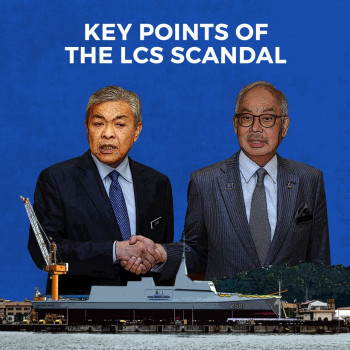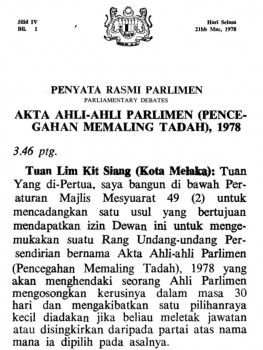By Low Kian Yung, Intern from Refsa (Research for Social Advancement)
 In his speech at the United Nations Climate Summit, Prime Minister Najib Razak proudly announced that Malaysia has already reduced the greenhouse emissions by more than 33%, and that the nation is well on track to hit the target of 40% reduction by 2020.
In his speech at the United Nations Climate Summit, Prime Minister Najib Razak proudly announced that Malaysia has already reduced the greenhouse emissions by more than 33%, and that the nation is well on track to hit the target of 40% reduction by 2020.
He said “In the past six years, Malaysia has taken a clear step towards a cleaner future. We have new policies to promote energy efficient vehicles, a new corporate greenhouse gas reporting programme, a building sector energy efficiency project and a low carbon city framework. And we are constructing a new urban mass transit system that could halve the number of cars on our city streets.”
In fact, if Malaysia were to achieve what our Prime Minister has promised to the world, there is so much to be debated to have a national energy policy with low carbon emission, sustainable, economically efficient, and sufficient to cater the current demand without sacrificing our children’s future interests.
Hence this is one of the topics discussed in SOCDEM ASIA Conference on Lessons and Best Practises for Local Democracy and Governance in the 21st Century, held in Penang on 2nd and 3rd December 2014.
The conference is co-organized by SOCDEM ASIA and Penang Institute, the main participants are the representatives of social democratic parties, local governments and NGOs from Southeast Asia countries.
Too many players sharing the cake
Member of Parliament for Serdang Dr. Ong Kian Ming who presented the topic acknowledged that Malaysia has a relatively sophisticated regulatory framework to support sustainable and green policies e.g. renewable energy (RE). As there are too many players involved in planning and lobbying for future energy needs, from the energy producers, regulatory agencies, suppliers to the customers, political capture is always an immediate danger to hijack the main purpose of the whole framework.
In 2013, the renewable energy generation capacity is merely 2.3% for the whole of Malaysia. Gas contributed approximately 50% of energy input in Peninsular Malaysia, with coal making up another 43%, and hydro energy 4.8%.
According to a Parliamentary Reply in 2014, the federal government projected to have 80% energy supplies from gas and coal by 2020, with renewable energy (RE) remaining at 3%. However, the Sustainable Energy Development Authority (SEDA) projected that by 2020, the nation would have 11% RE power mix, and 17% by 2030.
The figure is equivalent to reducing carbon emissions by 42.2 mt by 2020, and 145.1 mt by 2030. There are much more ambitious goals under EPP10 of the Economic Transformation Program (ETP) with its projection of having 14% RE by 2020 and 25% by 2030.
Although most of the energy firms are positive in projecting the increasing use and implementation of RE, Ong Kian Ming raised his worries that the efficacy might not be up on par with what have been projected, due to poor governance and culture of cronyism, which is always the root cause for many problems happening in the country.
“In 2013, even though there have been 536MW of Renewable Energy Feed in Tariff (REFIT) applications approved, only 240MW of the RE capacity installed at the end of 2014, 63% of which is Solar PV.”
There are only six years left to 2020, how far can we attain?
Political interference in the real danger
Even under normal circumstances, increasing RE capacity is difficult and faces many technical and financial challenges. But in Malaysia what is equally worrying is the ubiquitous political interference.
Ong Kian Ming pointed out that the only Geothermal plant project to be built in Tawau, Sabah is under Tawau Green Energy Sdn. Bhd (TGE). Who owns TGE? The largest shareholder with 52% shares is Yamani Hafez bin Musa, who is the son of Sabah Chief Minister, Datuk Musa Aman as well as the UMNO Youth Sipitang division youth chief. Another 52% of shares are owned by Datuk Awang Kadin Tang, the former Sabah UMNO Youth chief and currently deputy UMNO chief of the Sandakan division.
Meanwhile in April 2014, Tenaga Nasional has signed a power purchase agreement (PPA) with 1MDB Solad Sdn. Bhd. through direct negotiation, to build and operate the country’s largest solar power plant to date, and generate 50MW of renewable energy to TNB in the next 25 years.
Earlier in February, 1MDB has also been given a RM11 billion Track 3B contract to build a 2000MW coal fired plant, despite not being the lowest bid. In October, another 2000MW gas turbine power plant to be commissioned in 2021 has been awarded to 1MDB.
“Without open tender, large energy projects only benefit the mega corporations that is closely affiliated with government.”
Apart from these, Malaysia also risks having 2 nuclear plants to be build by 2024, although rumours have been denied by the government. The usefulness, legitimacy and need of the mega dam projects in Sarawak are also in questions.
Under the Sarawak Corridor of Renewable Energy, the state is foreseeing a 75% hydro power utility in 2015, and 67% in 2023. The 12 mega dams that are going to be built under the project are to generate a total capacity of 700MW by 2020, and an astounding 28,000MW by 2030.
However statistics show that the current demand of the state is only less than 1500MW, despite the fact that people in many villages are still living in the dark most of their lives, and this does not include the destruction of forest, ecosystem and the lifestyles of the native people throughout the construction of the dams.
Building sustainable energy and exploring alternative route to green solutions without considering the lost of social capital in the country that is irreplaceable and its effects irreversible, is this the way we want to go? Sustainable energy policies and projections cannot succeed without good governance.
Ong Kian Ming suggests that there are at least four aspects needed to take into serious consideration, first, ensure all bids for large energy projects are via open tender. Priority should be given to small scale projects which can benefit a large number of players, to the consumers as well as small businesses, instead of the big fishes.
The government should also consider to gradually increase the price of electricity in order to make renewable energy more competitive and viable. Last but not least, potentially controversial projects have to be always put under observation by third party, and stake holder consultation always operating.



